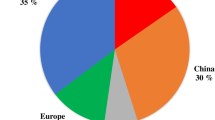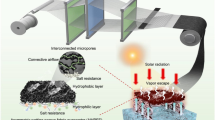Abstract
The proposed work is about the effectiveness of latent heat dispersion on energy storage using phase change materials with modified thermal stratifiers on charging inlet of the tank. A novel flow-governing nozzle with swirl flow injection is designed and fabricated to enhance the steady state of heat flow inside the cascaded thermal energy storage (TES) system. Spherical phase change materials (PCM) capsules with added multiwall carbon nanotubes (MWCNT) particles used as an energy storage material inside the TES tank. Experimentation conducted for the variable process parameters with mass flow rates, temperature, and injection pressure to differentiate the initial stratification of the thermocline system. Results obtained from the analysis clarify that with the increase in swirl number through injection pressure, temperature, and flow rate increases the steady state stratification behavior inside the cascaded TES tank. It is clear that the effective charging rate of 35 min observed from the system at 1 wt% of MWCNT with the increase in injection pressure and flow rate of 4 bar and 3 L/min. It also noted that the swirl effect increases the heat dissipation on the PCM capsules by maintaining a concentric heat transfer with the radial flow over the layers of the PCM capsules. Discharging trials are carried out by the batch-wise process to recover the stored thermal energy. Moreover, the cascaded latent heat thermal energy storage system using MWCNT-filled PCM is best suitable for water heating applications to overcome the intermittency.
















Similar content being viewed by others
Abbreviations
- T f, in :
-
HTF inlet temperature
- T f, out :
-
HTF outlet temperature
- Q inst :
-
Instantaneous heat transfer
- Q cum :
-
Cumulative heat stored
- S n :
-
Swirl number
- DSC:
-
Differential scanning calorimetric
- HDPE:
-
High-density polyethylene
- HTF:
-
Heat transfer fluid
- LHTS:
-
Latent heat thermal storage
- MWCNT:
-
Multiwall carbon nanotube
- OM:
-
Organic material
- PCM:
-
Phase change material
- PID:
-
Process identifier
- RTD:
-
Resistance temperature detector
- SEM:
-
Scanning electron microscope
- TEM:
-
Transmission electron microscope
- TES:
-
Thermal energy storage
References
Baek SM, Nam JH, Hong H, Kim CJ (2011) Effect of brine flow rate on the performance of a spiral-jacketed thermal storage tank used for SDHW systems: a computational fluid dynamics study. Appl Therm Eng 31:2716–2725
Dehghan AA, Barzegar A (2011) Thermal performance behavior of a domestic hot water solar storage tank during consumption operation. Energy Convers Manag 52:468–476
Dombrowski N, Hasson D (1969) The flow characteristics of swirl (centrifugal) spray pressure nozzles with low viscosity liquids. AlChE J 15(4):604–611
Eames PC, Norton B (1998) The effect of tank geometry on thermally stratified sensible heat storage subject to low Reynolds number flows. Int J Heat Mass Transf 41(14):2131–2142
Haller MY, Cruickshank CA, Streicher W, Harrison SJ, Andersen E, Furbo S (2009) Methods to determine stratification efficiency of thermal energy storage processes—review and theoretical comparison. Sol Energy 83(10):1847–1860
Ievers S, Lin W (2009) Numerical simulation of three-dimensional flow dynamics in a hot water storage tank. Appl Energy 86:2604–2614
Karthikeyan S, Solomon GR, Kumaresan V, Velraj R (2014) Parametric studies on packed bed storage unit filled with PCM encapsulated spherical containers for low temperature solar air heating applications. Energ Convers Manag 78:74–80
Karthikeyan S, Velraj R (2012) Numerical investigation of packed bed storage unit filled with PCM encapsulated spherical containers—a comparison between various mathematical models. Int J Therm Sci 60:153–160
Lavan Z, Thompson J (1977) Experimental study of thermally stratified hot water storage tanks. Sol Energy 19(5):519–524
Li G (2015) Energy and exergy performance assessments for latent heat thermal energy storage systems. Renew Sustain Energy Rev 51:926–954
Lokesh S, Murugan P, Sathishkumar A, Kumaresan V, Velraj R (2017) Melting/solidification characteristics of Paraffin based nanocomposite for thermal energy storage applications. Therm Sci 21(6A):2517–2524
Lizana J, Chacartegui R, Padura AB, Valverde JM (2017) Advances in thermal energy storage materials and their applications towards zero energy buildings: a critical review. Appl Energy 203:219–239
Michael FL, Volder D, Tawfick SH, Baughman RH, Hart AJ (2013) Carbon nanotubes: present and future commercial applications. Science 339:535–539. https://doi.org/10.1126/science.1222453
Moon S, Abo-Serie E, Bae C (2009) Air flow and pressure inside a pressure-swirl spray and their effects on spray development. Exp Therm Fluid Sci 33:222–231
Nallusamy N, Sampath S, Velraj R (2007) Experimental investigation on a combined sensible and latent heat storage system integrated with constant/varying (solar) heat sources. Renew Energy 32:1206–1227
Nallusamy N, Velraj R (2009) Numerical and experimental investigation on a combined sensible and latent heat storage unit integrated with solar water heating system. J Sol Energy Eng 131(4):041002
Oro E, Castell A, Chiu J, Martin V, Cabeza LF (2013) Stratification analysis in packed bed thermal energy storage systems. Appl Energy 109:476–487
Pakrouh R, Hosseini MJ, Ranjbar AA, Bahrampoury R (2017) Thermodynamic analysis of a packed bed latent heat thermal storage system simulated by an effective packed bed model. Energy 140(1):861–878
Pelay U, Luo L, Fan Y, Stitou D, Rood M (2017) Thermal energy storage systems for concentrated solar power plants. Renew Sustain Energy Rev 79:82–100
Rohita AK, Devi KP, Rangnekar S (2017) An overview of energy storage and its importance in Indian renewable energy sector Part I—technologies and comparison. J Energy Storage 13:10–23
Shah LJ, Furbo S (2003) Entrance effects in solar storage tanks. Sol Energy 75:337–348
Shaikh S, Banaszak U, VonLavante E, Cooper D, Yule AJ (2004) CFD prediction of the effects of viscosity on the internal flow of a scale pressure-swirl atomiser. In: 19th Annual meeting of the institute for liquid atomization and spray systems, Europe, Nottingham
Xie H, Lee H, Youn W, Choi M (2003) Nano fluids containing multiwalled carbon nanotubes and their enhanced thermal conductivities. J Appl Phys 94(8):4967–4971
Yaici W, Ghorab M, Entchev E, Hayden S (2013) Three-dimensional unsteady CFD simulations of a thermal storage tank performance for optimum design. Appl Therm Eng 60:152–163
Yang Z, Garimella SV (2010) Thermal analysis of solar thermal energy storage in a molten-salt thermocline. Sol Energy 84:974–985
Zelzouli K, Guizani A, Sebai R, Kerkeni C (2012) Solar thermal systems performances versus flat plate solar collectors connected in series. Engineering 4(12):881–893
Zhang S, Wang ZY (2018) Thermodynamics behavior of phase change latent heat materials in micro/nano- confined spaces for thermal storage and applications. Renew Sustain Energy Rev 82(3):2319–2331
Acknowledgements
I acknowledge that the present work is conducted under the financial grant offered by the Department of Science and Technology, India—Innovation in Science Pursuit for Inspired Research (INSPIRE) fellowship. Ref. No: DST/INSPIRE/03/2014/000347.
Author information
Authors and Affiliations
Corresponding author
Additional information
Technical Editor: Jose A. R. Parise.
Publisher's Note
Springer Nature remains neutral with regard to jurisdictional claims in published maps and institutional affiliations.
Rights and permissions
About this article
Cite this article
Selvam, L., Ramalingam, D. Experimental study on the cascaded thermal energy storage system using MWCNT-enhanced phase change materials. J Braz. Soc. Mech. Sci. Eng. 41, 572 (2019). https://doi.org/10.1007/s40430-019-2077-0
Received:
Accepted:
Published:
DOI: https://doi.org/10.1007/s40430-019-2077-0




